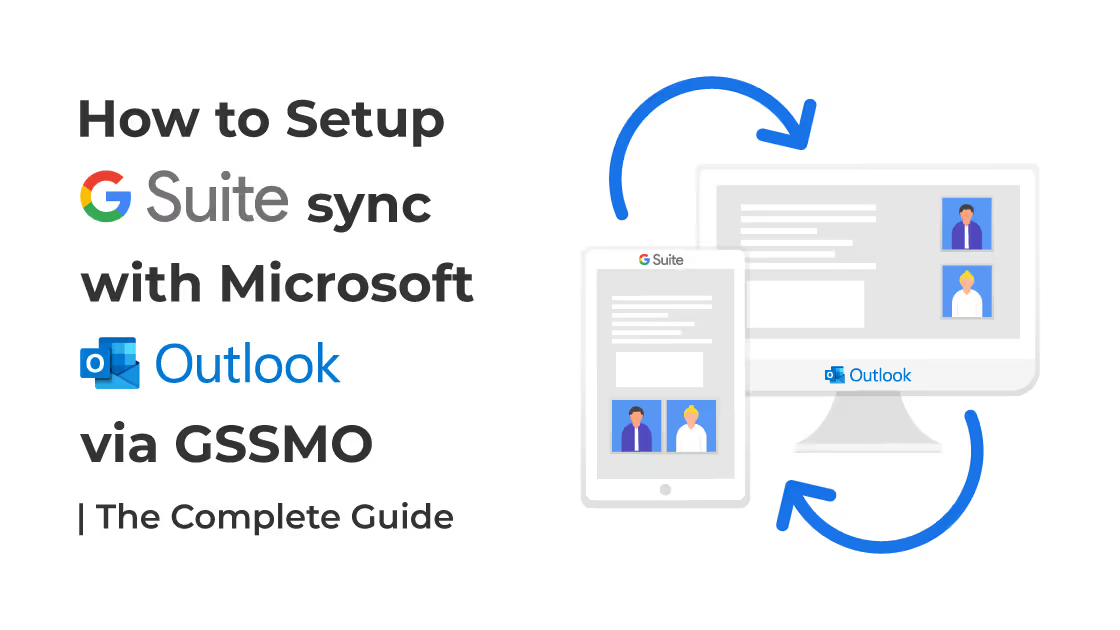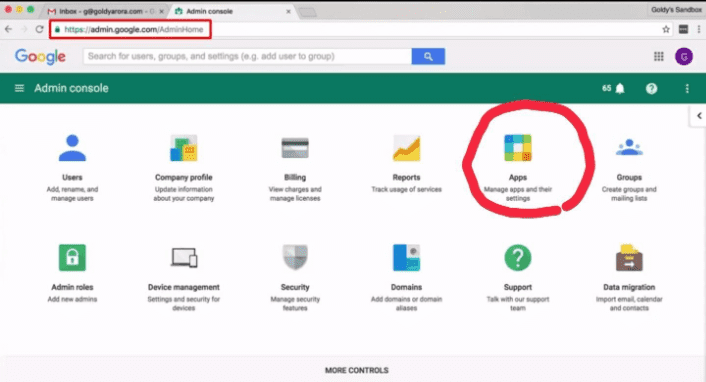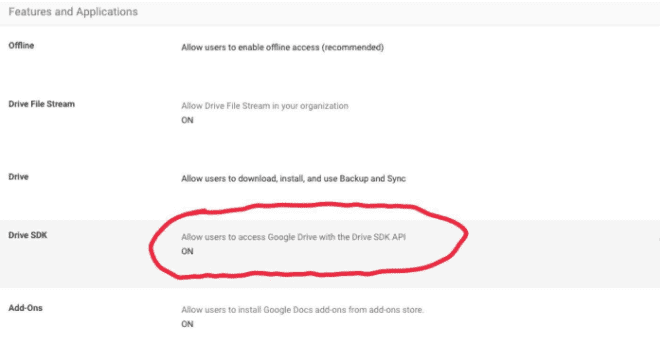How to Set up G Suite sync with Microsoft Outlook via GSSMO | The Complete Guide


Are you using G Suite and you want to use Outlook at the same time?
Have you been using Outlook for some time but you would like to switch to G Suite now as it offers more storage space.
You might think that if you moved to G Suite you may not be able to access all your previous mails and contacts stored in Outlook as G Suite is a tool provided by Google and Outlook is provided by Microsoft.
As technology has advanced this is not a problem and you can easily sync your Outlook data to your G Suite account by setting up G Suite sync with Microsoft Outlook via GSSMO application, which is a Windows-based utility.
GSSMO is a tool provided by Google to G Suite members and only your G Suite admin can set up GSSMO so that all G Suite members in your organization can synchronize their email, calendar, and contacts between G Suite and Outlook.
If you are not a G Suite admin you should ask your admin to do it for you.
G Suite is synchronized with Microsoft Outlook using MAPI (Messaging Application Programming Interface) which is a two-way synchronization that helps in storing data efficiently and accessing it easily from anywhere at any time.
As GSSMO relies on MAPI protocol you cannot use GSSMO with Mac OS.
You must fulfill the necessary prerequisites on your Windows platform to download the GSSMO tool.
Requirements for GSSMO Application
Operating system requirements:
- Windows Vista SP1 (32 and 64 bit)
- Windows 7 (32 and 64 bit)
- Windows 8 (32 and 64 bit)
- Windows 10 (32 and 64 bit)
Whichever version of Windows you are using you should upgrade to the latest version.
Outlook requirements:
- Microsoft Outlook 2003 SP3
- Microsoft Outlook 2007 SP2 (or SP1 with hotfix)
- Microsoft Outlook 2010 (32 and 64 bit) with hotfix
- Microsoft Outlook 2013 (32 and 64 bit)
- Microsoft Outlook 2016 (32 and 64 bit)
- Microsoft Outlook 2019 (32 and 64 bit)
As Microsoft Outlook 2003 and Microsoft Outlook 2007 are not actively supported by Microsoft you should upgrade to a supported version of Microsoft Outlook.
Port requirements
GSSMO will be using port 443 on your domain as it is the standard TCP port for websites that use SSL.
Port 443 is used to access any site whose URL starts with 'https', and GSSMO uses 'https' to connect to Google services.
If your site URL does not start with 'https' then you have to set it up.
Protocol
You must understand that GSSMO uses a proprietary GSSMO-specific Gmail sync protocol to connect to Google services and it does not use IMAP or STMP protocol.
How to set up GSSMO
To set up GSSMO in Google Admin Console
To do this you should sign in to your Google Admin Console and confirm your settings.
In Google, Admins Console goes to Apps and click on G Suite.

You have to make sure that Calendar, Directory, Drive and Docs, and Gmail have a Service Status of ON for everyone.
To turn on your Gmail
In your G Suite page click on 'Gmail Settings' and then 'Advanced Settings' and select 'Enable G Suite sync for Microsoft Outlook' then you must scroll down and click on 'Save'.

To turn on Calendar
Next, you should click on Calendar from Google Admin Console and click on 'Edit service' which you will find on the top right. Now you should choose 'ON for everyone' and then click on 'Save'.

To use Global Address List Generator
You have to enable the use of Global Address List Generator and to do this you should go to Google Admin console and click on 'Security' and then select 'API permission'.
Now you should click on 'Enable' which will be found next to Admin to grant API access to G Suite admin and then click on 'Save'.

To turn on Contact Sharing
You should do this to update the user's address/contact list.
In the Google Admin Console, you should go to Menu to enable contact sharing. You can then choose 'Directory' and click on 'Directory settings'.
Now you must select 'Sharing settings' and click on 'Contact sharing'. Select 'Enable contact sharing' and then click on 'Save'.

To turn on Drive service and Drive apps
You need to do this to synchronize notes and files to Drive
You should select 'Apps' in Google Admin console and then click on 'G Suite'. Select Drive and Docs, and then click 'Edit services' found on the top right of the Drive and Docs page.
You should click on 'On for everyone' and then click on 'Save'.

After you turn on the Drive service and Drive apps you should allow users to install Drive apps.
You should go back to Google Admin console select 'Apps' and then click on G Suite. Now you should select 'Drive and Docs' and then 'Features and applications'.
Here you must click on 'Drive SDK' and then select 'Allow users to access Google Drive with the Drive SPK API'. Then click on 'Save'

By doing all the above steps you would have set up GSSMO in your Google Admin console. The next thing which you have to do is to install GSSMO.
How to install GSSMO
You have two ways in which you can install GSSMO
Before you start the installation process you must inform all the users in your organization to install GSSMO if they want to sync G Suite with Outlook.
You have two ways in which you can install GSSMO
- You can download the .MSI file from the GSSMO download page, push the file to your users, and then secure your organization's applications.
You must make sure that you pick the correct edition of the .MSI file for your users because they may use a 32-bit edition or 64-bit edition of Outlook.
Your users can install the file by following the instructions.
- You can ask your users to download the .EXE file from the GSSMO download page and they can install the file by following the instructions.
When you install GSSMO you should know that G Suite Migration for Microsoft Outlook (GSMMO) also gets installed. GSMMO will allow you to migrate your data from Outlook to G Suite.
The downside of G Suite sync with Microsoft Outlook
Though you may find GSSMO as a convenient tool to sync G Suite with Outlook sometimes it does not work as it should. Sync errors may happen and then you will note that the synchronization between Google and Microsoft is not perfect.
You may even find your Outlook personal files or PST files corrupted due to sync errors. It will be a loss for you as both Google and Microsoft will not take responsibility for the data loss which happened due to sync errors.
In such cases, you will have to go for a third-party backup solution to reduce the impact of data loss.
When you are working with a weak internet connection GSSMO will not be available and there will be no synchronization. You may face this problem when you are using Outlook in offline mode.
GSSMO will not allow you to send an email as an attachment and you may not be able to open emails when they are sent as attachments.
GSSMO may fail to sync when you are trying to move emails from one folder to another in Outlook and you will not be able to find the corresponding folder in Gmail.
Conclusion
The greatest advantage is GSSMO helps you to use Outlook along with your G Suite account and enables you to sync data between G Suite and Outlook. Most of your email, calendar events, and contacts are synced flawlessly and regularly between G Suite and Outlook.
G Suite sync using GSSMO may not be perfect and you will run into problems. You may face issues now and then but most of them can be resolved quickly by either reinstalling Outlook and GSSMO or by recreating your G Suite profile.
You should be happy that GSSMO gives you an opportunity to get the benefits of Microsoft Outlook and also enjoy the security and reliability of Google Cloud.



.png)










